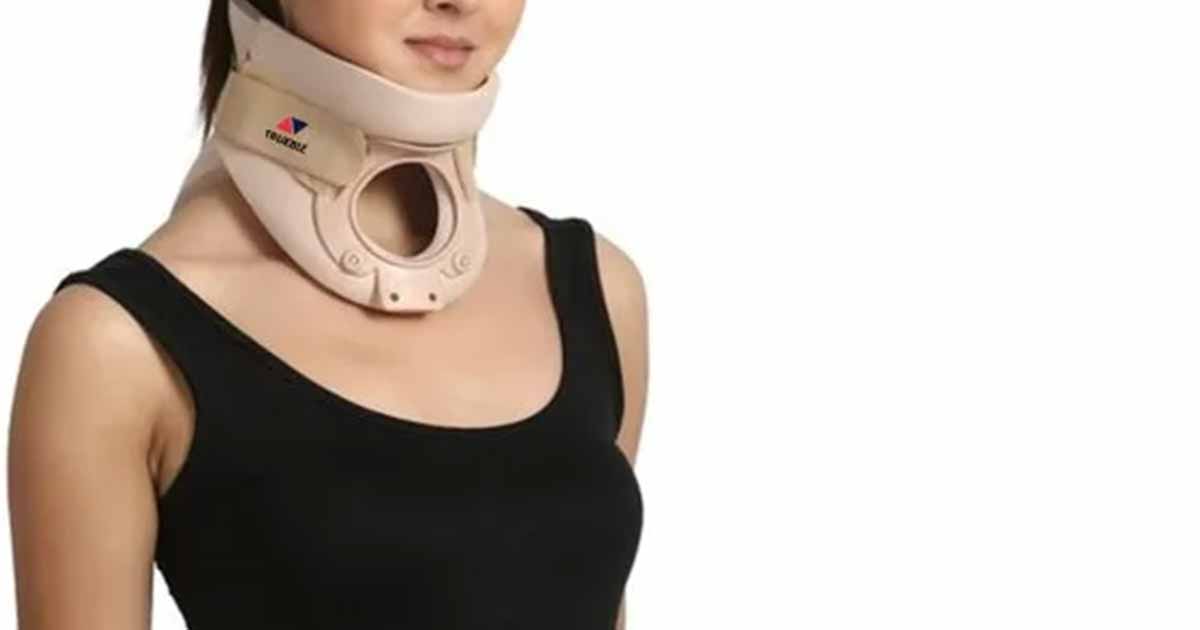Injuries to the cervical spine are common in trauma patients. Traffic accidents, sports accidents, and falls are among the leading causes of trauma injuries. In such scenarios, immobilization of the cervical spine with the right use of cervical collar is important.
Cervical collar or neck collar is now called cervical orthosis. The orthosis is worn around the neck, and fits everywhere from the jaw to the chest. It helps to restrict movement and acts as a support to the neck while healing from a cervical injury, fracture, or surgery.
The cervical collar will serve to decrease muscle spasms, align the neck at the center with the chin elevated slightly. It also provides support to the injured area, increasing stability and preventing further injuries.
It also reduces pains after spinal injury, post-op surgery, or in degenerative diseases that affect the neck strength.
Additionally, by immobilizing the c-spine, it limits motion by restricting neck flexion, extension, and lateral tilt (bending & rotation) but does not restrict axial loading.
Types of Cervical Collars
There are three main types of cervical collars: soft, semi-rigid and rigid.
Soft Cervical Collar
These types are made from thick foam rubber covered in cotton material. It comes in different hardness, and can be washed. The foam material is soft, elastic, breathable, comfortable, and can be used for sleeping.
It is used as a neck support, to treat minor neck strains, and control pain and pressure after an injury like whiplash. It can stabilize the cervical spine, improve recovery after surgery, torticollis, and poor head posture.
This type does not seem to increase the risk for secondary spinal injuries.
Rigid Cervical Collars
Made from molded plastic with a removable padded liner in two pieces – a front and back piece, fastened with Velcro. When it is applied and secured, the collar creates a rigid orthosis which supports the head and neck.
A hard cervical collar fit from your chin to the sternum or breastbone. It extends from the base of your head down to the top of your back. The top of the collar may also fit tightly around the lower jaw.
Some common products include the Philadelphia® collar, Miami J® collar, and Aspen® collar.
Rigid collar can cause complications and morbidity when used to immobilize a patient. Some of those complications are discomfort, increased intracranial pressure, impaired ventilation, masking of neck/occipital injuries, pressure areas, risk of aspiration, and worsening of spinal cord injury (e.g., in ankylosing spondylitis)
Semi-Rigid Cervical Collars
This type is made from soft semi-rigid foam (mid-density polyurethane foam) and restricts cervical motion control but does not reduce mobility. It is used in conditions such as whiplash, acute neck injuries, neck extension injuries, cervical spondylosis, arthritis in the neck, and rheumatoid arthritis.
Main Uses of Cervical Collar
- After acute injury, to prevent cervical spine fracture or spinal cord injury
- In chronic conditions such as arthritis or cervical metastasis.
- In non-acute injuries like strained cervical injuries.
Procedure on the Use of Cervical Collar
- Make sure you align the head of the patient to a neutral anatomical position to increase comfort
- Measure the distance between the base of the chin and the suprasternal notch.
- You can select the proper size collar by comparing the neck measurement of the patient with the width of the cervical chin support
- Slide the collar under the neck of the patient from left to right till you see the Velcro strap.
Instructions/Precautions on the Use of Cervical Collar
- Must be worn with tight-fitting to limit movement
- Wash and change the liners
- Each type of collar has specifics on how to wear
- Patient should avoid strenuous activities like lifting of weight, exercise
- The patient should lie on a bed that is not too soft but has firm support
- Driving or operating heavy equipment is not allowed
- Access the area of the skin under and around the collar frequently for redness, irritation, swelling, and make sure the skin integrity is maintained.
- The cervical collar should not be too tight to avoid interfering with breathing.
- While removing the collar, another person should help. Also, wash the face and neck daily.
Complications of Cervical Collar
- It may cause limitation in coughing, swallowing, breathing, vomiting and potentially aspiration
- May increase cranial pressure
- Improper cervical immobilization can cause additional spinal cord injuries during hospitalization
- May increase exposure to transmission of blood-borne diseases.
- May result in skin damage especially occiput, shoulders, chin and mandible, ears, sternum, laryngeal prominence, and macerated neck skin, and the risk of pressure ulcers.
- Delays intubation or difficulty weaning from the ventilator
- May lead to marginal mandibular nerve palsy (cranial nerve VII), and long-term sensory compromise.
- Lack of mobility may increase the risks of deep vein thrombosis, pneumonia, ileus. It can also cause the breakdown of sacral pressure points, heel, and elbow.
- Can cause anxiety and discomfort.
Contraindications
- Severe neck injuries like cervical vertebral fractures
- In cases of massive soft tissue swelling in the neck.
- Penetrating neck injury
References:
- https://www.ambulance.qld.gov.au/docs/clinical/cpp/CPP_Cervical%20collar.pdf
- https://criticalcareontario.ca/wp-content/uploads/2020/10/Care-of-Cervical-Orthosis-Devices-and-Collar-Care.pdf
- https://myhealth.alberta.ca/health/AfterCareInformation/pages/conditions.aspx?hwid=abn2923&
- https://www.orthotic-braces.com/product/soft-foam-cervical-neck-brace-for-adult-or-kids
- https://www.bettercaremarket.com.au/semi-rigid-cervical-collar-push-care.html












